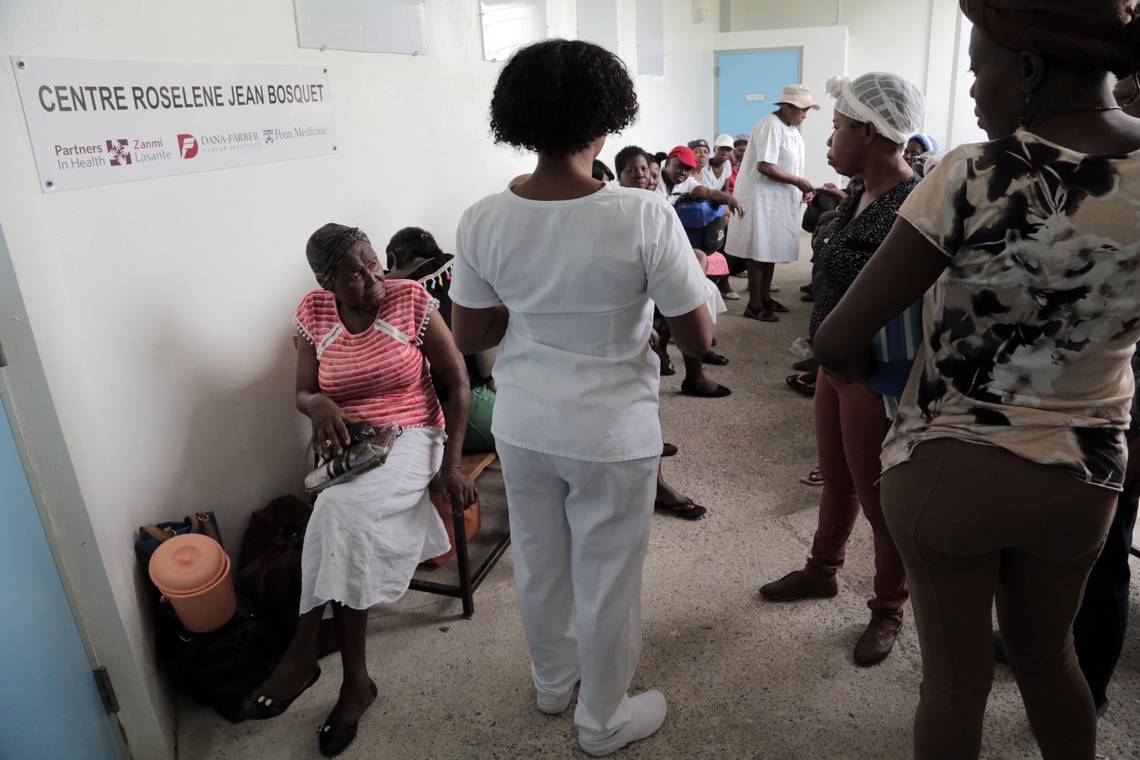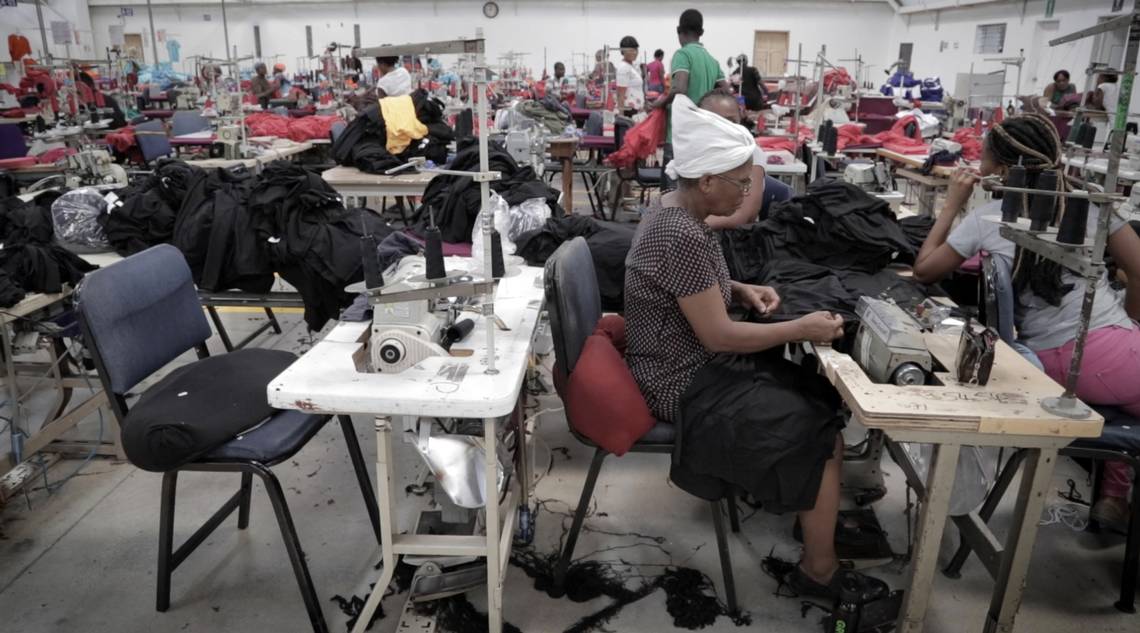
PORT-AU-PRINCE — At the back of a T-shirt factory in an industrial park north of Port-au-Prince, women line up for one of the country’s newest methods of cancer prevention.
The treatment room is bare bones: a dusty company clinic, three midwives and a single bed separated from lines of whirring sewing machines by a rough wooden wall and a thin blue curtain.
The next patient, who stepped away from the assembly line a moment earlier, climbs onto the bed and digs her heels into the edges of the mattress to allow the midwife, Nanotte Louis, to examine her.
Louis’ tools are simple. A light from a cellphone, a bottle of Heinz vinegar to test for abnormal cells on the woman’s cervix and a hand-held, battery-operated heat gun to zap any precancerous cells if the area turns “aceto-white” from the acid in the vinegar. Less than a minute later, it’s over — another woman treated to prevent cervical cancer.
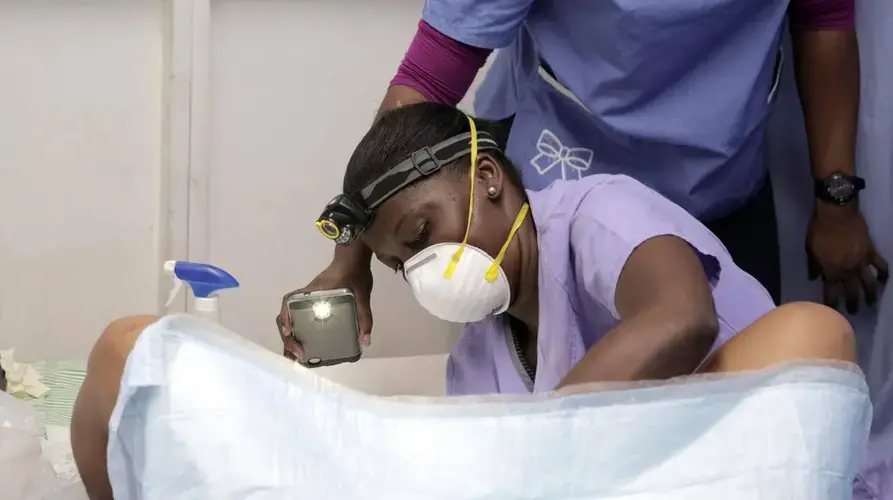
Newly released cancer figures by the World Health Organization estimate the number of annual deaths in Haiti from cervical cancer to be 563. Healthcare providers operating the cancer clinic at the University Hospital of Mirebalais in central Haiti say it’s 1,500 or more, based on their data over the last 10 years.
But they all agree cervical cancer rates are high in Haiti, where “see-and-treat” programs like this one at the Caribbean Island Apparel factory are quietly gaining ground as a grassroots way to treat the problem in a country where rudimentary cancer care is as scarce as reliable electricity.
“The hardest part with ... cervical cancer screening is we’re trying to convince a woman to take a test on a disease that she most likely won’t have and if she does have, she most likely won’t get symptoms for it for 10 years,” said Dr. Vincent DeGennaro Jr., the founder of Innovating Health International, which provides low-cost cancer care and is behind the factory screenings. “It’s difficult to convince people.”
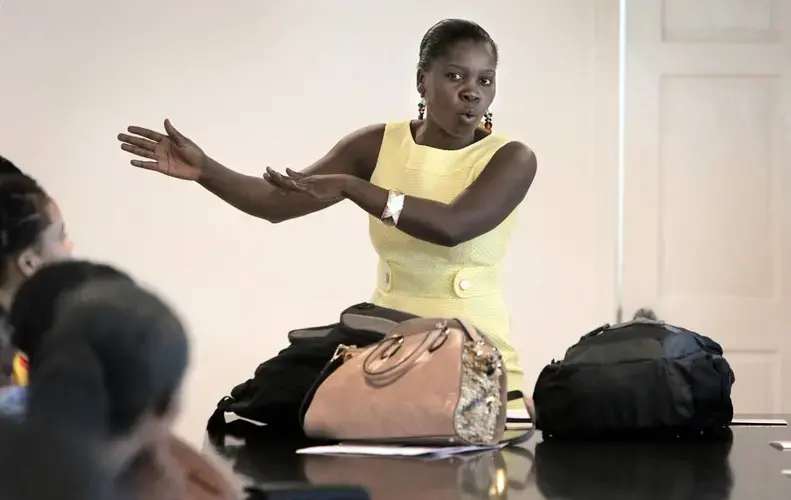
And yet their lives could depend on it. The factory program is designed to remove traditional barriers to treatment so that more women will get screened. They can be treated without losing a day’s work, which can make the difference between getting help and not getting it. They don’t have to tell their husbands or get them to pay for treatment in a society where women often need permission from their partners to take care of their own bodies. And they are screened — and treated, if necessary — on the spot.
“Cervical cancer is spread by the HPV virus, and it’s a sexually transmitted virus and in every culture in the world, this has been a fraught conversation,” said DeGennaro. “In a lot of places, the men are the ones who pay for healthcare and they are the gatekeepers for their woman’s access to healthcare. And Haiti is no different.”
Programs like the one in the factory are giving more women in Haiti control over their own care. Since last October, DeGennaro’s health-focused non-governmental organization and Share Hope Haiti, which helps garment workers access social services, have persuaded 3,200 factory workers between the ages of 30 and 50 to get screened for cervical cancer by undergoing two tests.
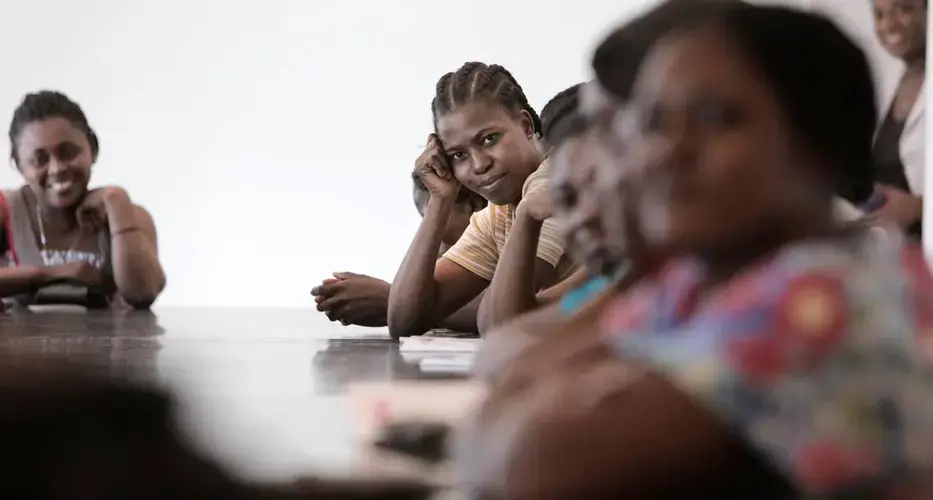
The first test is for HPV, the human papillomavirus responsible for most cancers of the cervix. The women collect their own samples with a cotton swab. If they are HPV positive, they undergo a visual inspection of the cervix — using acetic acid, or vinegar — to see if the area turns white, indicating abnormal cells.
Heat is then used to destroy the superficial layer of the cervix where the HPV-infected cells are located. Those who are HPV negative are instructed to get tested again in five years.
“When you tell someone they’re negative, they are happy,” Louis, 40, said. “But when you tell the person they are [HPV] positive, you have to do counseling.” She added that the women are told that while they don’t have cancer, they are still at risk and there’s treatment.
Because screenings are not part of most Haitian women’s routine healthcare, many cases of cervical cancer are so far advanced that when the disease is discovered, even surgery to stop its spread is no longer an option.
Iyliomene Saint-Louis, 35, decided she wanted to find out if she had precancerous lesions or was at risk for the painful disease, two weeks after Louis visited her factory to educate the women workers.
As Creole gospel hymns played over the humming of the industrial sewing machines, Saint-Louis kept her eyes on a door at the Inter-American Woven factory. When she spotted the midwife, Saint-Louis left her work station and headed to the infirmary, a tiny room with shower curtains for privacy and a handwritten poster in Creole about cervical cancer.
Though Saint-Louis, the mother of two, had heard of kansè kòl matris — as cervical cancer is called in Creole — she hadn’t been sure how to prevent it. She had once considered getting a Pap test, she said, but could never take the time off from work. The price was a problem, too. It cost six times her $5-a-day minimum wage.
But when she heard Louis’ impassioned speech, she was convinced.
“I called my husband. I told him there was a test, and I asked if I could get it done,” she said. He agreed.
Two weeks after self-collecting her specimen for testing, Saint-Louis found out she was infected with HPV: “I was afraid I would die.”
Louis, though, told her she had just taken a powerful step to save her own life. And after the treatment was over, Saint-Louis agreed.
“I’m happy I found out early,” she said.
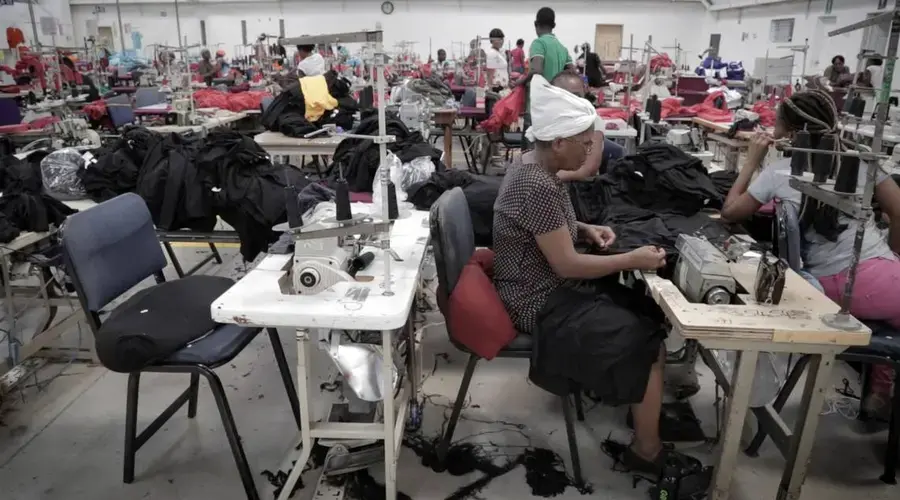
Most women in Haiti don’t get a chance to receive preventive care. They don’t end up at a doctor until their cervical cancer is advanced. For them, radiation is a key treatment, along with chemotherapy, but it isn’t available in Haiti. Traveling to the neighboring Dominican Republic for radiation therapy is an option, but the $10,000 to $15,000 price tag is often far too much. Palliative care to ease a woman’s pain is sometimes the only treatment left.
“Not having radiation will lead to some patients dying who might have survived,” said Dr. Lawrence Shulman, senior oncology adviser for Partners In Health and director of the Center for Global Cancer Medicine at the Abramson Cancer Center at the University of Pennsylvania. “[The] use of radiation together with chemotherapy provides the highest cure rates.”
Healthcare providers in Haiti, some of whom are pushing to get radiation to the Caribbean nation, say the cancer shouldn’t get to that stage.
“When we think of cervical cancer control, you think of prevention, early intervention, as well as curative treatment and palliative care,” said Dr. Sarah E. Slater, an oncologist at Mount Auburn Hospital in Boston, who volunteers with the oncology team at the Mirebalais hospital, which provides free cancer care.
She said the medical community in Haiti is painfully aware that women there need to be educated about the importance of prevention and early treatment.
“How do you get people in for Pap smears? How do you make HPV vaccinations more common and more prevalent? That’s sort of the earlier interventions that you could do to prevent these late presentations of cervical cancer,” Slater said.
In June, doctors, nurses and nonprofits working in cancer care around Haiti spent two days in a Port-au-Prince conference center discussing questions like those as part of an effort to create a national cervical cancer prevention program. Led by a consortium of U.S.-based partners known as Haiti sans Cervical Cancer, the group aims to improve access to screenings, testing and services. It is also working to create a cervical cancer registry in Haiti with the help of the University of Miami’s Sylvester Comprehensive Cancer Center.
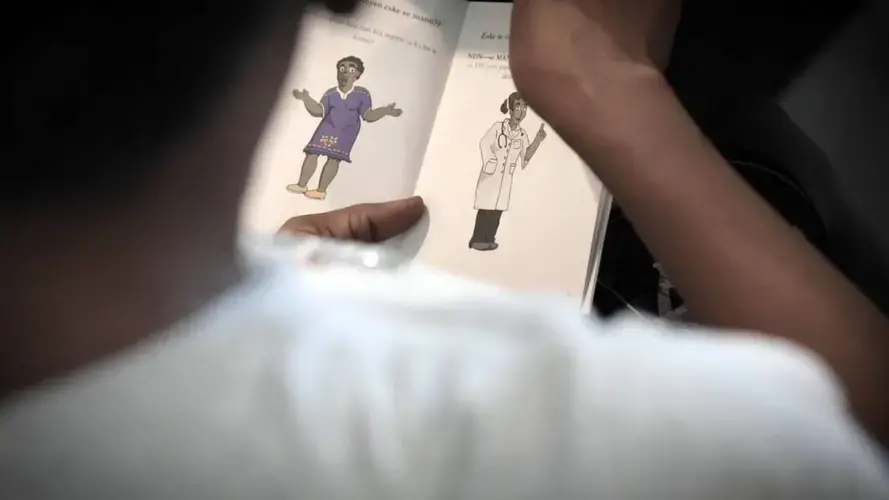
Unifying cancer resources in Haiti is particularly important given the country’s fractured history with outside groups coming in to help after disasters such as the 2010 earthquake.
“Part of the problem with Haiti is that there are too many NGOs, each wanting to do ‘something’ for the Haitian people. Consequently, different groups drop in and perform cervical cancer screenings but haven’t thought through the process as to how they will notify the patients once they leave or where they will refer those women who have disease,” said Dr. Leslee Jaeger, a Minneapolis obstetrician-gynecologist who volunteers in northern Haiti and led some of the discussions at the conference.
Dr. Jennifer Goldman, the head of the Primary Care program at Memorial Healthcare System in Broward County, agrees. When she and her physician husband, Kissinger Goldman, first began working in rural Haiti to screen women for cervical cancer by conducting Pap smears, they ran into obstacles that included a three-month wait for test results because of a lack of pathologists to interpret them.
Tracking down patients once they had results and getting those with abnormal results to return for a colposcopy — a magnified examination of the cervix — also were difficult. The frequent lack of electricity added another layer of complication to any treatment.
But early this year, the Goldmans found a solution to a lot of those problems. They began using a $3,500 cellphone-based mobile colposcope that allows doctors to use their smartphones to take a magnified photo of a woman’s cervix to help them detect pre-cancer.
“When you take a picture, you can show it immediately. We tell them: This is what a normal cervix looks like and this is what yours looks like and it can turn to cancer,” Jennifer Goldman said. “I then ask if they would like for me to treat it, and then we treat it.”
In June, as other cancer providers were meeting in the capital, the Goldmans were training about 100 Haitian healthcare professionals from across the country how to conduct “see-and-treat” cervical cancer screenings using visual inspections and the mobile colposcope. They also screened 600 women inside a classroom in rural Pignon, three hours north of Port-au-Prince.
“We are not focused on running our own clinics and leaving,” Goldman said. “This is why we are training Haitian physicians, nurses and midwives, so that they can do this exam and continue to do this exam after we leave.”
Training local medical professionals is critical because programs like the one in the Port-au-Prince factory are dependent on outside funding that can dry up. At Share Hope, program coordinator Delphine Kanyandekwe said the $75,000 grant from the government of Canada that pays for the factory cancer screening program is about to end even though the program has helped hundreds of women — many keeping their families financially afloat — and could help hundreds more.
“They support four, five, six family members. People rely on them for food, for caring, for education,” she said.
But educating women about healthcare that can save their lives continues to be a challenge. During a recent seminar in a glass-enclosed conference room above the factory at Cleveland Manufacturing, which makes sportswear and kids’ wear, Louis, the midwife, gave her talk again.
She elicited some nervous laughter and a lot of silence as she discussed cervical cancer’s relationship to HPV. Multiple sex partners, she told them, puts you at high risk. So does having sex early in life.
And no, taking the test won’t have any effect on your libido, she added, to laughter.
In some cases, she said, husbands have refused to allow their wives to be treated for precancerous lesions because it means abstaining from sex for two to four weeks afterward.
“But you also find that [the test] is something they’ve been looking for,” Louis said. “On numerous occasions, I’ve had women come up to me and thank me.”
The grassroots screenings aren’t the only initiatives under way to reverse Haiti’s cervical cancer problem. One effort, the cervical cancer consortium Haiti sans Cervical Cancer, is working with Haitian healthcare professionals to create a prevention program that includes screening, education and a registry.
There’s a push to make the HPV vaccine routine for girls. The Haitian medical nonprofits Zanmi Lasante vaccinated more than 25,000 preadolescent girls in central Haiti and GHESKIO inoculated 2,000 girls in Port-au-Prince as a demonstration project.
And Dr. Robert Auguste, a gynecologist and former Haiti health minister who is trying to track all kinds of cancer in Haiti for the government, has started a National Cancer Registry.

Auguste — along with Innovating Health International and Partners In Health, which opened its new cancer clinic at the Mirebalais hospital earlier this year — also hopes to bring radiation to Haiti. Machines can cost $5 million or more and require trained medical radiation workers and a national regulatory infrastructure for the safe use of ionizing radiation.
Globally, there is an ongoing debate about how best to screen women for cervical cancer in low-resource countries like Haiti. While Pap smears are standard in the U.S., they are costly in Haiti and, in general, not as reliable as HPV testing in detecting precancerous changes, according to a recent study and some doctors.
Dr. David Walmer, an associate professor at the Duke Global Health Institute and founder of Family Health Ministries, a nonprofit working in Haiti, has spent more than 25 years screening women in Haiti for cervical cancer. He’s also researched the reliability of Pap smears, colposcopy and HPV testing in the seaside town of Léogâne.
He’s now a proponent of testing for HPV as the best way to identify those at high risk for developing cervical cancer even though the tests, which require a lab and cost about $10 a kit, are more expensive than visual inspection of the cervix. Both Pap smears and visual inspection, he said, often miss precancerous conditions in women.
Adding the HPV vaccine to doctors’ cancer-fighting tool kit in Haiti has been hard, too. The public-private international vaccine alliance, Gavi, which helps developing countries find funding to buy the HPV vaccine, says Haiti doesn’t meet the minimum standard for its assistance. That assistance requires that a country have more than 70 percent of its children inoculated against diphtheria, tetanus and pertussis. Haiti’s vaccination rate was 60 percent in 2017.
“This is to ensure that a country has a strong enough immunization system to ensure this complex vaccine, which needs to reach a different age group than any other vaccine, can be introduced successfully,” said Frédérique Tissandier, spokesman for Gavi. “Unfortunately, Haiti’s basic coverage is well below that.”
Three years ago, Zanmi Lasante, the Haiti-based sister organization to Partners In Health, did try to get Haiti’s health ministry to incorporate the HPV vaccine into the childhood vaccination program. Elizabeth Campa, senior health and policy adviser for the group, said it didn’t receive a response to the idea.
Still, in 2016, Zanmi Lasante managed to get Merck & Co. to donate 59,000 vials of the HPV vaccine, valued at $9.4 million, and introduced it in central Haiti.
But cultural mores have frustrated efforts to inoculate girls. Though the campaign was a success, Campa conceded that about 1,000 girls dropped out between the first and second rounds of vaccinations because school officials convinced parents that it would make their daughters sexually active at a younger age.
“We have a vaccine out there that can literally prevent a certain type of cancer from ever developing in a woman’s body,” Campa said. “But it’s not in Haiti because the country doesn’t meet minimum standards. Meanwhile women are dying when you can prevent them from developing cancer.”
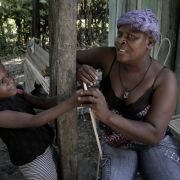
Education Resource
Meet the Journalists: Jacqueline Charles and José Antonio Iglesias
"If people don't know that the problem exists, then how can you even begin to find a solution?"...



